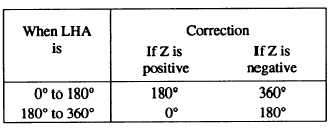where:
Z =
LHA =
6
=
a =
azimuth of the sun measured
clockwise from north
local hour angle of the sun
declination of the sun
latitude of the observer
Z is normalized from 0° to 360°
algebraically a correction as listed below.
by adding
The above equation is derived using spherical
trigonometry to solve the pole-zenith-star (PZS) triangle
for azimuth
Time and Date
To calculate the LHA of the apparent sun at the
instant of observation, you must have accurate time that
takes into account the rotation of the earth. Time that is
based on the rotation of the earth can be obtained by
adding a correction factor to Greenwich meantime.
Coordinated universal time (UTC) is another
name for Greenwich mean time and is broadcast by the
National Bureau of Standards on radio station WWV.
(Inexpensive receivers that are pretuned to WWV are
available.) The correction factor (designated DUT) that
you must add to the coordinated universal time is also
obtained from WWV by counting the number of double
ticks following the minute tone. Each double tick
represents a tenth-of-a-second correction and is positive
the frost 7 seconds (ticks). Beginning with the ninth
second, each double tick is a negative correction. The
total correction, either positive or negative, will not
exceed 0.7 second. By adding DUT to UTC, you get
time (designated UT1) that is based on the actual
rotation of the earth.
A stopwatch with a split (or lap) time feature is ideal
for obtaining times of pointings. The stopwatch is set by
starting it on a WWV minute tone and then checking it
1 minute later with a split time. If a significant difference
is observed, start and check the stopwatch again. Split
times are taken for each pointing on the sun and added
to the beginning UTC time, corrected to UT1.
To enter the ephemeris tables, you must know the
Greenwich date for the time of observation. For an
afternoon observation (local time) in the Western
Hemisphere, if the UT1 is between 12 and 24 hours, the
Greenwich date is the same as the local date. If the UT1
time is between 0 and 12 hours, the Greenwich date is
the local date plus 1 day.
For a morning observation (local time) in the
Eastern Hemisphere, if the UT1 time is between 0 and
12, the Greenwich date is the same as the local date. If
the UT1 time is between 12 and 24 hours, the Greenwich
date is the local date minus 1 day.
For a morning observation in the Western
Hemisphere and an afternoon observation in the Eastern
Hemisphere, Greenwich and local dates are the same.
Latitude and Longitude
Both the observer’s latitude and longitude are
required for the hour angle method. Usually these values
can be readily obtained by scaling from a map, such as
a USGS 7.5-minute quadrangle sheet. For sun
observations, locating the observer’s position on the
map and scaling must be performed to a reasonably high
degree of accuracy.
Declination of the Sun
Declination (6) of the sun is tabulated for O hours
universal time of each day (Greenwich date) in table
15-5. You can interpolate for at the UT1 time of
observation by using the following equation:
A negative declination indicates that the sun is south
of the equator, and a negative value must be used in the
above equation and in the azimuth (Z) equation.
The Greenwich hour angle (GHA) of the sun is
tabulated for 0 hours universal time of each day
(Greenwich date) in the ephemeris. Interpolation is
required at the UT1 time of observation and can be
accomplished by using the following equation:
NOTE: The value at the beginning of the day of
observation is d’. The value 24 hours later at the
beginning of the next day is 24h.
15-18



